Sundararaja D. The Discrete Fourier Transform. Theory, Algorithms and Applications
Подождите немного. Документ загружается.


324
Discrete Walsh-Hadamard Transform
Input
Vector
Formation
Stage 1
Output
Stage 2
Output
Stage 3
Output
x(0)
x(8)
*(1) [31
x(9) LU
x(2) m
ar(10)LU
x(3) [I
x(ll)[_0
x(4)
x(12)
x(5)
x(13)
x(6) fT|
x(14)LU
*(T)
m
x(15)liJ
E H
4
-2
5
1
li
10
-2
6
4
10
-6
20
0
11
1
-8
4
a
h
-l
8
0
4
-2
0
2
0
0
-1
3
PH
i
-4
-4
5
-1
E i
a
3ll
X
nh
(0)
9j X
nfe
(l)
U
X
nh
{3)
Tl X
nh
(4)
r9j
X
nh
(5)
Til X
nft
(6)
U X„
h
(7)
FT] *nft(8)
LU *nh(9)
Fl X
nh
(W)
1
I
^nh(H)
X„ft(12)
X
n7l
(13)
X
nh
{U)
X„/>(15)
Fig. 16.6 The trace of the PM NDHT algorithm, with N = 16.
It can be shown that the computation of 2-D NDHT is the same as that of
1-D NDHT. As such the SFG remains the same except that the data length
is N
2
. If data is read row-by-row from the input file, the output would be
written row-by-row and vice versa.
Example 16.6 Compute the 2-D NDHT of the matrix of data given in
Example 16.3.
Solution
Computing the 1-D NDHT of the rows, we get
6
9
6
0
-2
7
2
2
2
-1
4
-4
-2
1
0
0
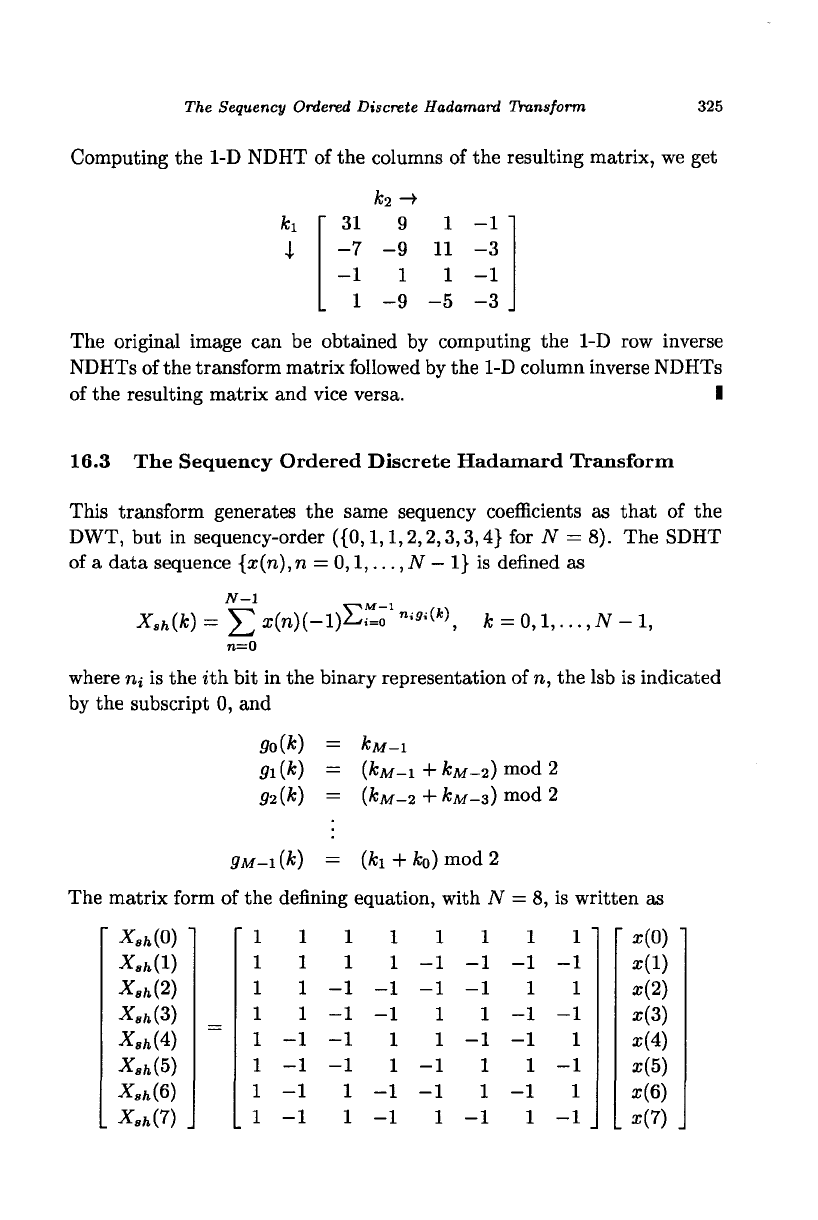
The Sequency Ordered Discrete Hadamard Transform 325
Computing
the 1-D
NDHT
of the
columns
of the
resulting matrix,
we get
fcl
I
k
2
->•
"
31 9
-7
-9
-1
1
1
-9
1
11
1
-5
-1
-3
-1
-3
The original image
can be
obtained
by
computing
the 1-D row
inverse
NDHTs of the transform matrix followed
by the 1-D
column inverse NDHTs
of
the
resulting matrix
and
vice versa.
I
16.3
The
Sequency Ordered Discrete Hadamard Transform
This transform generates
the
same sequency coefficients
as
that
of the
DWT,
but in
sequency-order ({0,1,1,2,2,3,3,4}
for N = 8). The
SDHT
of
a
data sequence {x(n),n
=
0,1,...,
N
—
1} is
defined
as
N-l
M
_
1
X
ah
(k)
= £
x(n)(-l)^i=~
0
n
^
(fc)
,
A;
=
0,1,...,
AT-1,
n=0
where
rii is the ith bit in the
binary representation
of n, the lsb is
indicated
by
the
subscript
0, and
g
0
(k)
= k
M
-i
9i {k)
= {k
M
-i + k
M
-2) mod 2
52(k)
= (&M-2 + k
M
s) mod 2
9M-I
(k) = (h +
fc
0
)
mod 2
The matrix form
of the
defining equation, with
N = 8, is
written
as
"
X.
h
(0)
'
X
ah
{\)
X
8h
{2)
X
sh
(3)
X
sh
(A)
X
sh
(5)
X
8h
(6)
X
8h
(7)
1
1 1 1-1-1-1-1
1
1-1-1-1-1 1 1
1
1-1-1 1 1-1-1
1-1-1 1 1-1-1 1
1-1-1 1-1 1 1-1
1-1 1-1-1 1-1 1
1-1 1-1 1-1 1 -1
•
ar(0) "
x(l)
x{2)
x(3)
x(4)
x(5)
x(6)
.
*(7) .

326
Discrete Walsh-Hadamard Transform
"a 1
O
fe 0
0
B
1
1
CI 0
.. 00
& 1
•
0
"a 1
S. 0
^ 00
=s 1
•
•
2
2
4
it
(a)
4
n
(c)
• •
•
6
•
6
m
•
•
"e 1
5°
°
& -1
•
0
"s 1
C 0
.. 00
£ 1
•
0
"a 1 t»
!C 0
^ 00
fe 1
•
•
•
2
2
•
4
n
(b)
•
4
n
(d)
•
a
•
•
6
6
•
<•)
"a
1
f
£ 0
& -1
(f)
1 M • • •
0
-1 L • . • . • . •.
(g) (h)
Fig. 16.7 The SDHT basis functions, with N = 8.
The SDHT basis waveforms,
W
N
(k,n)
= (-l)E";
1
"•»<(*), n,fc = 0,l,...,JV-l,
are shown in Fig. 16.7, with N — 8. It can be seen that the waveforms
are sequency ordered and are similar to the DFT basis waveforms. This
kernel can be obtained by rearranging the DWT kernel in gray-code order
(0,1,3,2,6,7,5,4, for
AT
= 8). The inverse SDHT is given by
1
N_1
M-l
x
^ =
JJ
E *.ft(*)(-l)
Si
-°
ni9i{k)
>
n =
0,1,...,
iV
- 1
k=0
Example 16.7 Let x{n) =
{1,3,5,7}.
Compute the SDHT of x(n). Get
back x(n) by computing the inverse SDHT of the sequency coefficients.
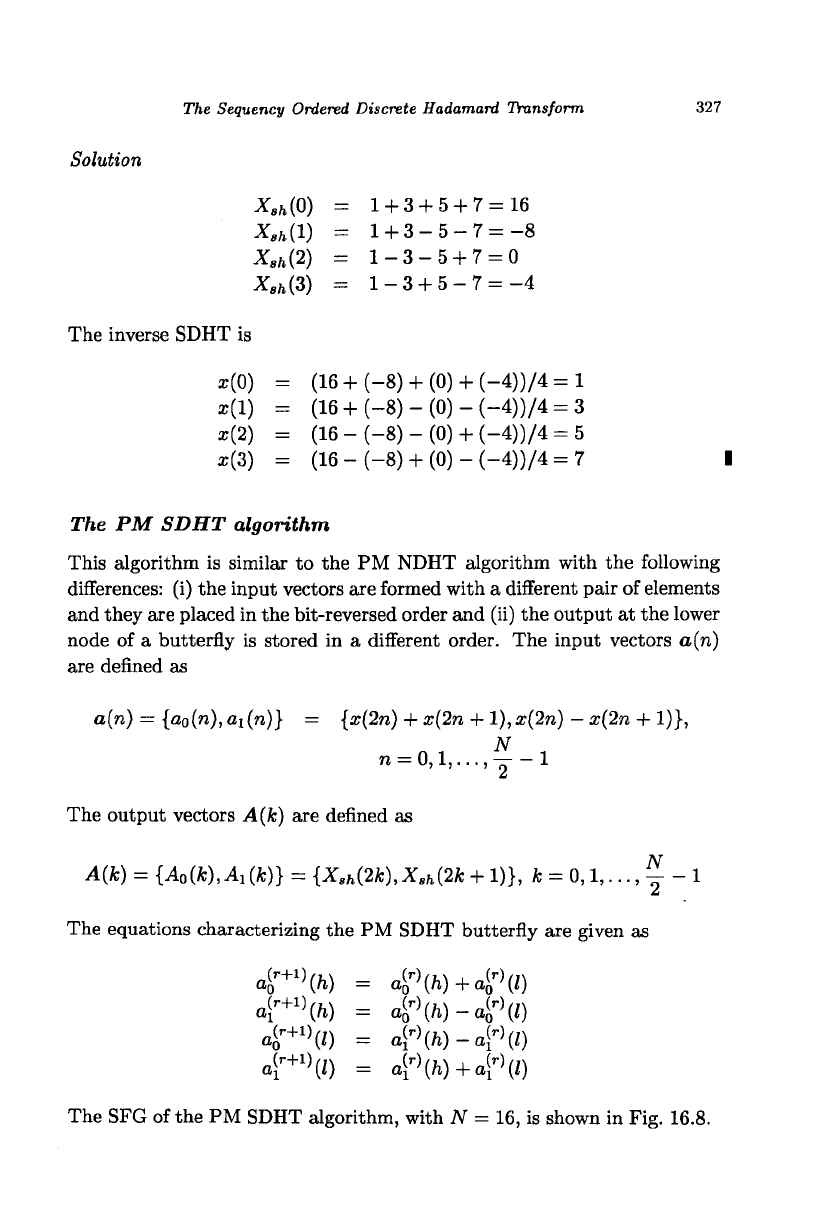
The Sequency Ordered Discrete Hadamard Transform 327
Solution
X
8h
(0)
X
8h
(l)
X
8h
(2)
X
sh
(3)
The inverse SDHT is
x(0) = (16 + (-8) + (0) + (-4))/4 = 1
x(l) = (i6 + (-8)-(0)-(-4))/4 = 3
x{2) = (16 - (-8) - (0) + (-4))/4 = 5
*(3) = (l
6
-(-8) + (0)-(-4))/4 = 7 I
The PM SDHT algorithm
This algorithm is similar to the PM NDHT algorithm with the following
differences: (i) the input vectors are formed with a different pair of elements
and they are placed in the bit-reversed order and (ii) the output at the lower
node of a butterfly is stored in a different order. The input vectors a(n)
are defined as
a(n) = {a
0
(n),ai(n)} = {x{2n) + x{2n + l),x(2n) - x(2n + 1)},
N
n = 0,l,...,y-l
The output vectors A(k) are defined as
A(k) = {A
0
(k), A^k)} = {X
8h
(2k),X
sh
(2k + 1)}, fc =
0,1,...,
y - 1
The equations characterizing the PM SDHT butterfly are given as
4
r+1)
(/i)
= a£\h)+a£\l)
a?
+1
\h)
=
4
p)
(/»)-4
r)
(0
ai
r+1
\l) = a[
r
\h)-a[
r
\l)
af?
+1
\l) = o[
p)
(/i)+a[
r)
(Q
The SFG of the PM SDHT algorithm, with N = 16, is shown in Fig. 16.8.
= 1 + 3 + 5 + 7 = 16
= 1+3-5-7=-8
=
1-3-5+7=0
=
1-3+5-7=-4

328
Discrete Walsh-Hadamard Transform
o(0)
o(4)
o(2)
«(6)
o(l)
o(5)
o(3)
o(7)
stage 1 stage 2 stage 3
>
A(0)
A(l)
A(2)
A(3)
•A(4)
A(5)
A(6)
^(7)
Fig. 16.8 The SFG of the PM SDHT algorithm, with N = 16.
The 2-D SDHT
The 2-D SDHT of an JV x JV image {x(ni,n
2
), ni,n
2
=
0,1,...,
N - 1}
is defined as
*.*(*!,to) = £ E x(n
1
,n
2
)(-l)
(
S";
1
("0^(fc
1
)+E"o
1
^)'^^»,
ni=0n2=0
fcl,fc
2
=0,l,...,JV-l
Example 16.8 Compute the 2-D SDHT of the matrix of data of Exam-
ple 16.3.
Solution
Computing the 1-D SDHT of the rows, we get
6 2-2-2
9-117
6 4 0 2
10-4 0 2
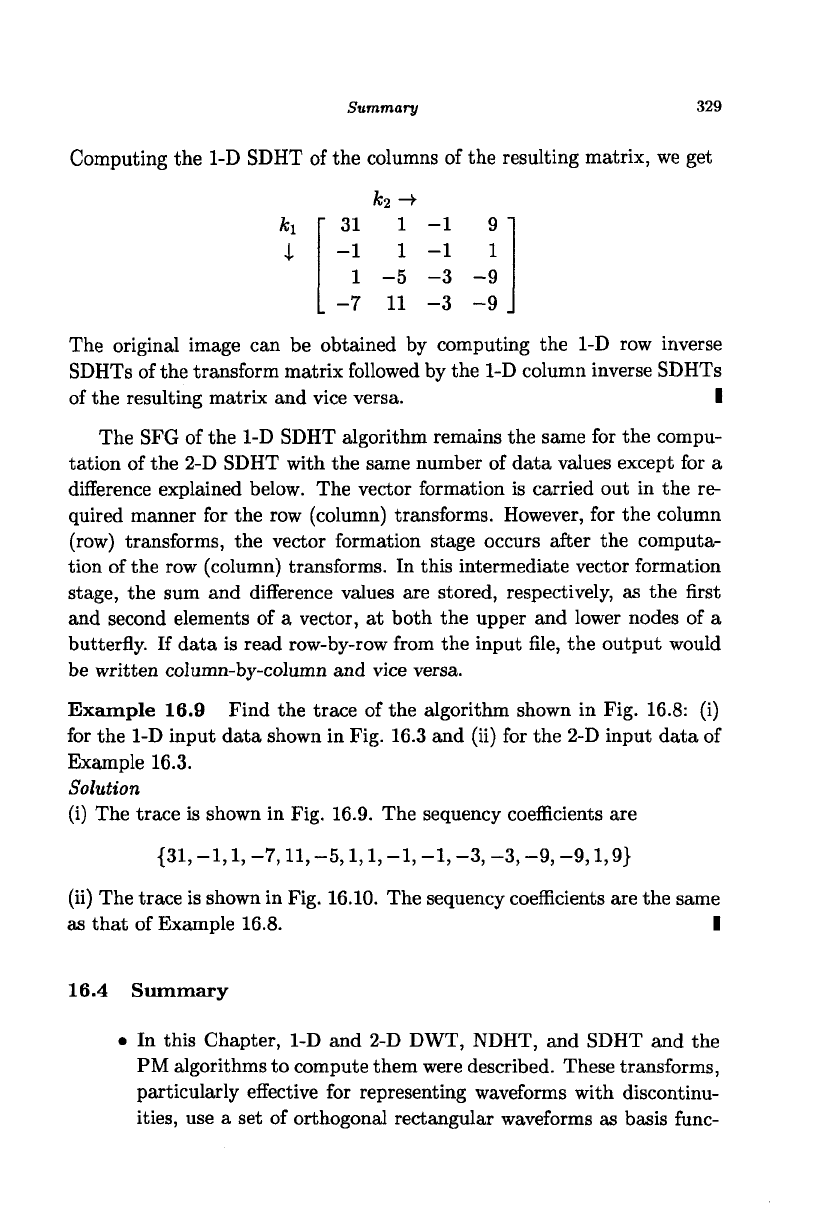
Summary
329
Computing the 1-D SDHT of the columns of the resulting matrix, we get
fc
2
-»•
31 1-1 9 "
-1 1-1 1
1 -5 -3 -9
-7 11 -3 -9 .
The original image can be obtained by computing the 1-D row inverse
SDHTs of the transform matrix followed by the 1-D column inverse SDHTs
of the resulting matrix and vice versa. I
The SFG of the 1-D SDHT algorithm remains the same for the compu-
tation of the 2-D SDHT with the same number of data values except for a
difference explained below. The vector formation is carried out in the re-
quired manner for the row (column) transforms. However, for the column
(row) transforms, the vector formation stage occurs after the computa-
tion of the row (column) transforms. In this intermediate vector formation
stage, the sum and difference values are stored, respectively, as the first
and second elements of a vector, at both the upper and lower nodes of a
butterfly. If data is read row-by-row from the input file, the output would
be written column-by-column and vice versa.
Example 16.9 Find the trace of the algorithm shown in Fig. 16.8: (i)
for the 1-D input data shown in Fig. 16.3 and (ii) for the 2-D input data of
Example 16.3.
Solution
(i) The trace is shown in Fig. 16.9. The sequency coefficients are
{31, -1,1, -7,11, -5,1,1, -1, -1,
-3, -3, -9, -9,1,9}
(ii) The trace is shown in Fig. 16.10. The sequency coefficients are the same
as that of Example 16.8. I
16.4 Summary
• In this Chapter, 1-D and 2-D DWT, NDHT, and SDHT and the
PM algorithms to compute them were described. These transforms,
particularly effective for representing waveforms with discontinu-
ities,
use a set of orthogonal rectangular waveforms as basis func-
i
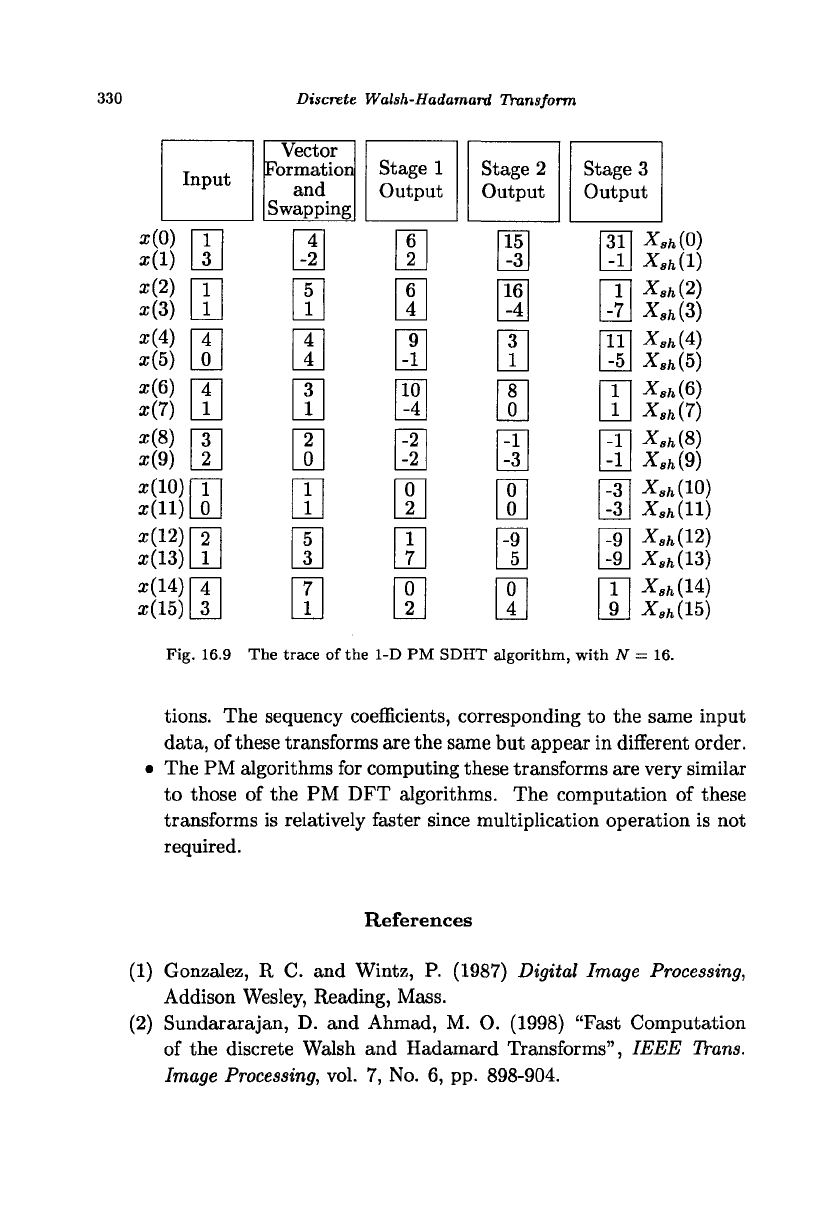
330
Discrete Walsh-Hadamard Transform
Input
Vector
Formation
and
Swapping
Stage 1
Output
Stage 2
Output
Stage 3
Output
x{0
x(l
x(2
x (3
x (4
x(5
x(6
x(7
x(8
x(9
z(10)
z(ll)
*(12)
z(13)
a;(14)
x(15)
_3_
a
a
a
3
2
1
0
2
1
I
1
1
a
9
-1
10
-4
-2
-2
3
1
8
0
-1
-3
a
a a
0
0
-9
5
0
4
a
-9
-9
1
9
3T1
X
sh
(0)
Gn x
8h
(i)
X
8h
(2)
X
8h
(3)
mn x
sh
(4)
Lil x
sh
(5)
m
^
ft
(6)
nn Jf.fc(8)
X,
fc
(10)
X
8h
(U)
X.
fc
(12)
Jf.h(13)
X
gh
(14)
X,
fc
(15)
Fig. 16.9 The trace of the 1-D PM SDHT algorithm, with N = 16.
tions.
The sequency coefficients, corresponding to the same input
data, of these transforms are the same but appear in different order.
The PM algorithms for computing these transforms are very similar
to those of the PM DFT algorithms. The computation of these
transforms is relatively faster since multiplication operation is not
required.
References
(1) Gonzalez, R C. and Wintz, P. (1987) Digital Image Processing,
Addison Wesley, Reading, Mass.
(2) Sundararajan, D. and Ahmad, M. O. (1998) "Fast Computation
of the discrete Walsh and Hadamard Transforms", IEEE Trans.
Image Processing, vol. 7, No. 6, pp. 898-904.
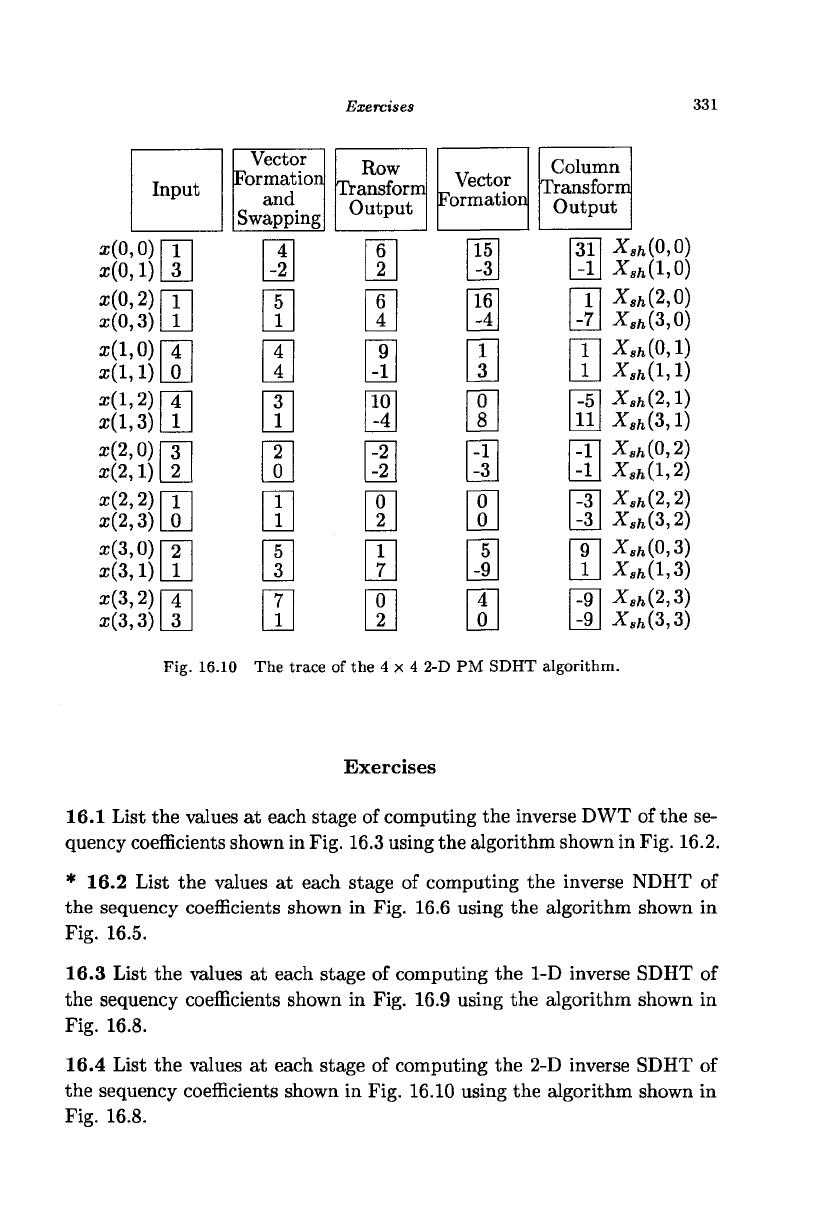
Exercises
331
x(0, 0
X(0,
1
z(0,2
x(0,3
x(l,0
x(l,l
x(l,2
x(l,3
z(2,0
z(2,l
x(2,2;
a;(2,3
z(3,0
a;(3,1
z(3,2
z(3,3
Vector
Formation
and
Swapping
Row
Transform
Output
Vector
Formation
Column
Transform
Output
m
5
1
4 1
4 ]
re
-
4
nr
-i
16
-4
1
3
1
-7
nn
j
10
-4
-2
-2
0
8
-1
-3
[-b\
11
-1
-1
0
0
5
-9
-3
-3
9
1
4
0
-9
-9
*
8
fc(0,0
X
8h
{\,Q
X
sh
%Q
X
sh
(Z,Q
X
sh
{Q,\
X
8h
(l,\
X
sh
(2,l
X
s
h(3,1
X
s/l
(0,2
X
sft
(l,2
-X»fc(2,2
-^»fe(3,2
*
8
ft(0,3
^sfe(l,3
^«ft(2,3
^»/j(3,3
Fig. 16.10 The trace of the 4 x 4 2-D PM SDHT algorithm.
Exercises
16.1 List the values at each stage of computing the inverse DWT of the se-
quency coefficients shown in Fig. 16.3 using the algorithm shown in Fig. 16.2.
* 16.2 List the values at each stage of computing the inverse NDHT of
the sequency coefficients shown in Fig. 16.6 using the algorithm shown in
Fig. 16.5.
16.3 List the values at each stage of computing the 1-D inverse SDHT of
the sequency coefficients shown in Fig. 16.9 using the algorithm shown in
Fig. 16.8.
16.4 List the values at each stage of computing the 2-D inverse SDHT of
the sequency coefficients shown in Fig. 16.10 using the algorithm shown in
Fig. 16.8.
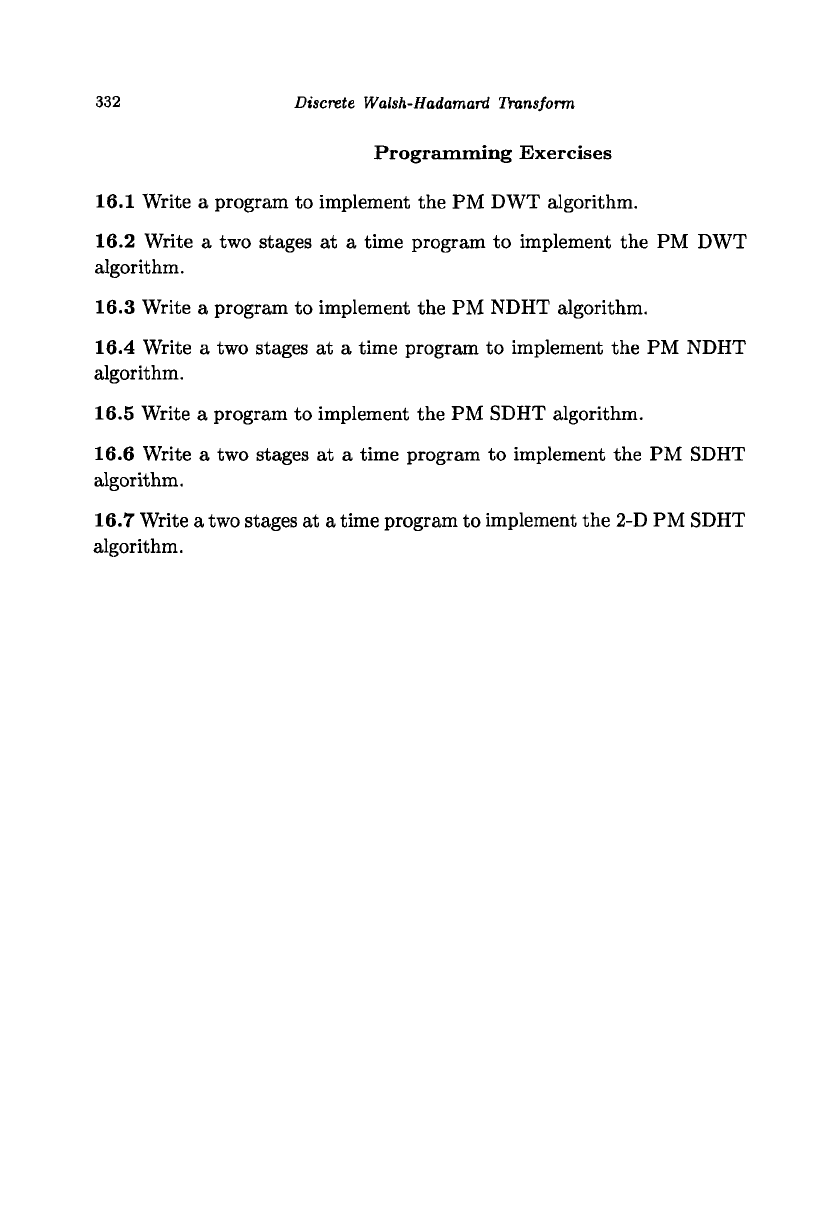
332 Discrete Walsh-Hadamard Transform
Programming Exercises
16.1 Write a program to implement the PM DWT algorithm.
16.2 Write a two stages at a time program to implement the PM DWT
algorithm.
16.3 Write a program to implement the PM NDHT algorithm.
16.4 Write a two stages at a time program to implement the PM NDHT
algorithm.
16.5 Write a program to implement the PM SDHT algorithm.
16.6 Write a two stages at a time program to implement the PM SDHT
algorithm.
16.7 Write a two stages at a time program to implement the 2-D PM SDHT
algorithm.
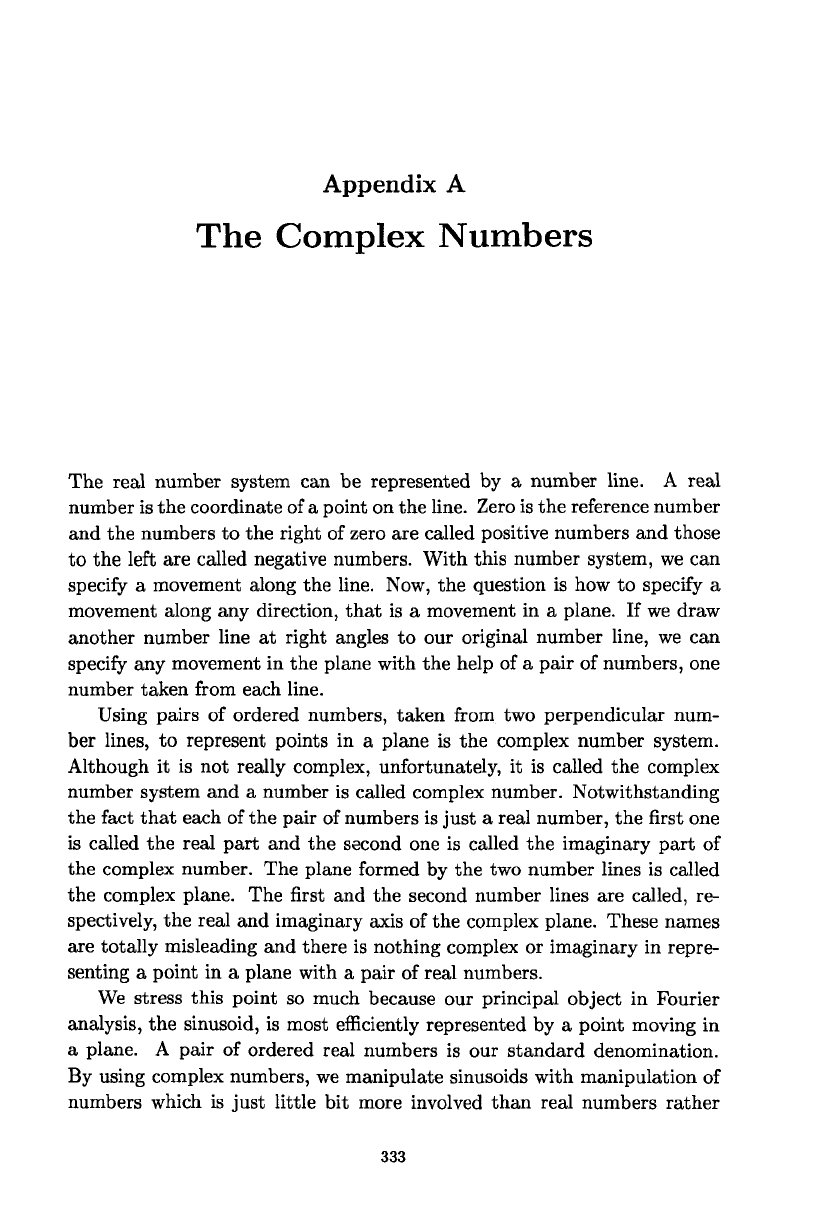
Appendix A
The Complex Numbers
The real number system can be represented by a number line. A real
number is the coordinate of a point on the line. Zero is the reference number
and the numbers to the right of zero are called positive numbers and those
to the left are called negative numbers. With this number system, we can
specify a movement along the line. Now, the question is how to specify a
movement along any direction, that is a movement in a plane. If we draw
another number line at right angles to our original number line, we can
specify any movement in the plane with the help of a pair of numbers, one
number taken from each line.
Using pairs of ordered numbers, taken from two perpendicular num-
ber lines, to represent points in a plane is the complex number system.
Although it is not really complex, unfortunately, it is called the complex
number system and a number is called complex number. Notwithstanding
the fact that each of the pair of numbers is just a real number, the first one
is called the real part and the second one is called the imaginary part of
the complex number. The plane formed by the two number lines is called
the complex plane. The first and the second number lines are called, re-
spectively, the real and imaginary axis of the complex plane. These names
are totally misleading and there is nothing complex or imaginary in repre-
senting a point in a plane with a pair of real numbers.
We stress this point so much because our principal object in Fourier
analysis, the sinusoid, is most efficiently represented by a point moving in
a plane. A pair of ordered real numbers is our standard denomination.
By using complex numbers, we manipulate sinusoids with manipulation of
numbers which is just little bit more involved than real numbers rather
333
